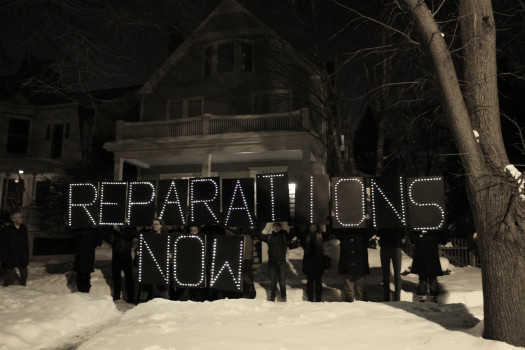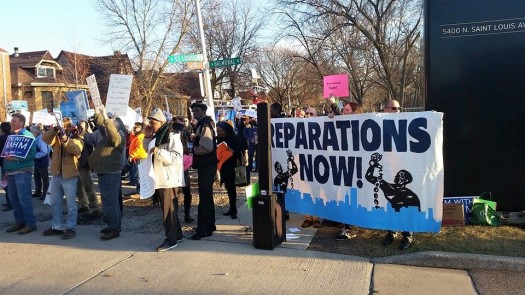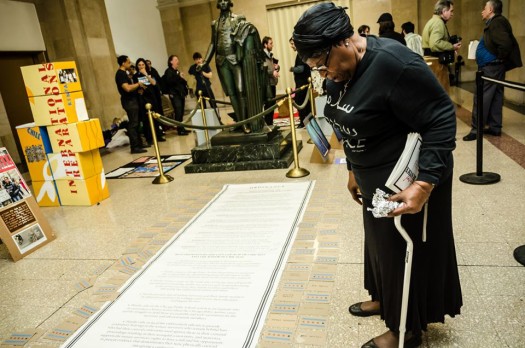Interrupting The Death-Making: Notes from Chicago
Driven to a deserted field on the far Southside of Chicago, Darrell Cannon was scared to death. It was 1983 and the police wanted a confession. Darrell was terrorized with Russian roulette while being called a nigger. Officers attached cattle prods to his genitals and electrically shocked him. After hours of torture, he confessed to murder and spent over 20 years in prison. Fourteen of those caged inside a torture chamber called TAMMS supermax.
There isn’t enough money on earth to make up for such violence and torture. Apologies don’t erase the impact(s) of state-sanctioned violence. These things are true and yet such transgressions demand redress. Over the past few months, I’ve written about a re-animated campaign to pass a reparations ordinance for Burge torture survivors. The ordinance was introduced in October 2013 and had been stalled in the Chicago City Council. I’m on the advisory board of Chicago Torture Justice Memorials (CTJM) which is the group that introduced the ordinance. I’ve had a long-standing interest in the Burge police torture cases but only fully engaged over the past 6 months to pass the ordinance.
Today, CTJM announced the framework of a deal with the City of Chicago on the reparations ordinance. “Rooted in a restorative framework and reflecting critical provisions of the original Reparations Ordinance filed in October of 2013, the reparations package the City has agreed to includes a myriad of remedies that aim to meet the concrete needs of the Burge torture survivors and their family members. It will include:
1. A formal apology from the Mayor and City Council for the torture and abuse committed by Chicago Police Commander Jon Burge and police officers under his command;
2. A permanent public memorial acknowledging the torture committed by Burge and his men;
3. Inclusion of a lesson in the Chicago Public Schools 8th and 10th grade U.S. History curriculum on the Burge torture cases;
4. Provision of trauma and other counseling services to the Burge torture survivors and family members at a dedicated facility on the South Side of Chicago based on the model of services provided by the Marjorie Kovler Center and Heartland Alliance;
5. Free tuition or job training at Chicago’s City Colleges for Burge torture survivors, their family members, including grandchildren;
6. Job placement for Burge torture survivors in programs designated for formerly incarcerated people;
7. Priority access to City of Chicago’s re-entry support services, including: job training and placement, counseling, food, housing & transportation assistance, senior care, health care, and small business support services;
8. Financial compensation to the Burge torture survivors who are still with us today.
The City will set aside $5.5 million to establish a Reparations Fund for Burge Torture Survivors. Every person found to have a credible claim of torture or abuse committed by Burge or his men at Area 2 and 3 Police Headquarters from 1972 to 1991 will receive the same exact amount from the fund.”
Though we did not obtain everything that we wanted (particularly in terms of the financial compensation), all of the provisions of the original reparations ordinance are reflected in the final deal. We wanted and want more. However, the reality is that most of the Burge torture survivors have no recourse to sue the City, some remain locked up today, and they are getting older. They have been left with nothing but their needs. This legislation will provide a path to address those material and other needs. The ordinance was conceived as a living memorial. It is an abolitionist document that asks us to imagine and enact different forms of justice.
Daily we are inundated with all kinds of violence, suffering and pain. This can lead, as Howard Thurman (1961) has written, to “a kind of devastated deadness.” We can begin to feel powerless, impotent. Organizing is how I interrupt the violence and death-making to catch my breath. Organizing is an attempted rupture of the oppressive and death-making status quo. Organizing is about contending with and building power. Organizing means never being satisfied and always demanding more. Organizing has its own grammar, cadence, and music. But above all, organizing is fueled by and creates hope. Marshall Ganz is right:
“Hope is not only audacious, it is substantial. Hope is what allows us to deal with problems creatively. In order to deal with fear, we have to mobilize hope. Hope is one of the most precious gifts we can give each other and the people we work with to make change.”
And I know that for some, hope is in short supply these days. And why should it not be? We are witness to and experience the daily annihilation of black people at the hands of the state. We know how disposable we are. We are always aware of the precarity of our existence. What does it mean to “win” within the strictures of an unjust oppressive society? Why bother to resist?
We resist, I think, because we are entitled to live, to breathe, to be. In his well-known 1966 speech at Berkeley, Stokely Carmichael said: “I am black, therefore I am.” Yes, exactly and also I resist, therefore I am. I’m blessed to know Darrell Cannon. His experience of torture has animated my organizing. Watching him speak at today’s hearing was both inspiring and gut-wrenching. As he recounted his torture, he cried. “I’m crying because I am mad,” he told a packed room, “I’m still mad.” I resist too because of Darrell.
I resist because of the torture survivors still caged in Illinois prisons. I resist because I want those who were tortured and are no longer with us to know that we have not forgotten. Refusing to forget is resistance. We remember through organizing and struggle. Julius Lester (1968) wrote that his slave ancestors’ “lives were lived on a spider web stretched over the mouth of hell.” I’ve always felt those words viscerally. I believe that Burge’s victims’ “lives were (also) lived on a spider web stretched over the mouth of hell.” So we owe them the fight for some justice. We owe it to them not to forget. We owe that to ourselves too.
Decades of struggle in Chicago have led to today. Small ‘victories’ have paved the road: getting Jon Burge fired from the police force, a perjury conviction, survivors telling their stories and being believed. Soon this ordinance will be a brick in the long road to justice. There is still more work ahead to pass the ordinance and beyond it. Organizing is a marathon.
Darrell Cannon says that he cannot forget his experience of torture. Now the history and legacy of that violence will be taught in Chicago Public Schools. The future will remember Darrell’s torture too. His life matters. In the words of Dr. Joy James, #BlackLivesMatter because we make them. Making #BlackLivesMatter is our work here in Chicago, the ordinance is a contribution to that goal.



